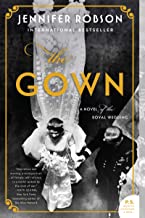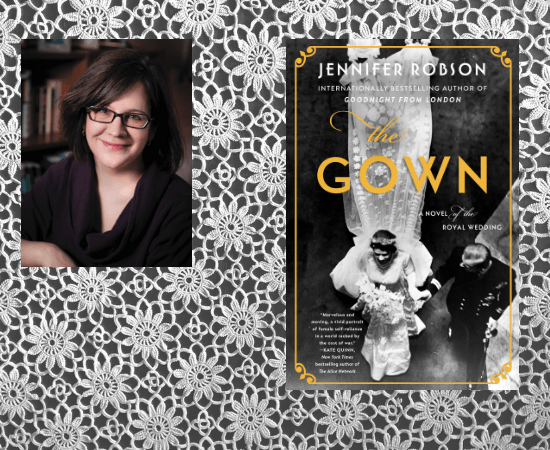The Gown by Jennifer Robson
In 1947, the world set its weary eyes on a royal wedding when Princess Elizabeth married Philip Mountbatten. The war had ended just two years earlier, and the British were still living in hard times, with food and gas rationing and insufficient housing. And so, as winter approached, the prospect of a beautiful princess in a dazzling gown cheered the nation.
In The Gown: A Novel of the Royal Wedding (William Morrow), Jennifer Robson’s fifth novel, she returns to a favorite theme – women and the ravages of war. In light of such tragedy, it may seem unlikely that a gorgeous dress, designed, sewn, and embroidered at the atelier of British dressmaker Norman Hartnell, is at the center of the story. But the creation of the gown, the hours spent in the workrooms and the curiosity it arouses, will change the lives of three women and two men in astonishing ways.
When word arrives that the princess has chosen a design by Hartnell, the gifted embroiderers Ann Hughes and Miriam Dassin are chosen to execute the painstaking work of embroidering the bodice, skirt and train. Inspired by the figure of Primavera in Botticelli’s Spring, Hartnell designed a gown of silk encircled by star lilies, roses, wheat, and orange blossoms, composed of crystal beads and seed pearls.
Ann, whose brother was killed in the Blitz, and Miriam, a refugee from France, end up sharing a house as well as working together. They are tentative in their friendship, for each woman is naturally reticent. During the few months that the women devote hours to the gown, sometimes in silence, sometimes in conversation, one will encounter great happiness and the other shock and affliction. Ultimately Miriam stays in England while Ann moves to Canada. They will not see each other again.
The Gown is a story about secrets – from the details of the dress itself, eagerly sought by reporters, to the darkness that haunts Miriam, to the pain that Ann keeps hidden. Ultimately it is Ann’s granddaughter, intrigued by embroidery that her grandmother bequeathed to her, who sets out to find the truth.
BookTrib spoke with the author about the book, the period, and, of course, the gown.
![]()
Claudia Keenan: Was Princess Elizabeth’s 1947 wedding the first royal wedding where the gown received so much attention?
Jennifer Robson: It was, and the thirst for details of Princess Elizabeth’s gown, fueled by the ever-increasing speed with which information and photographs could be sent around the world, was many times greater than at previous royal weddings. The windows in the sewing and embroidery workrooms at Hartnell had to be whitewashed to keep out prying eyes, and the staff often had to run a gauntlet of journalists when they entered or left the premises.
The gown was also an object of interest because clothes rationing was still in place, and there was concern that Princess Elizabeth would not be allowed to have a traditional wedding gown because of restrictions. People were so worried that they began sending the princess their clothing coupons, which was technically illegal as coupons couldn’t be given away. In the end, the government voted to grant her a special ration of extra coupons so she could have her gown without breaking the law.
CK: Do you think that the designer Norman Hartnell was unusually kind to the women who worked for him?
JR: When I first began to research The Gown, I assumed I would come across evidence that Hartnell was difficult or demanding, or in some way convinced of his own superiority because of his frequent commissions from the royal family. What I quickly discovered, however, was how thoroughly liked and admired he was. Try as I might, I couldn’t uncover a single criticism of him as a person. He paid his workers well, at least by the standards of the time, long hours were a rarity at Hartnell, and he even had a canteen (or cafeteria) installed for the use of his workers.
CK: Were you one of those little girls who dreamed of an ornate wedding gown?
JR: I was, and it was all because of Diana’s wedding gown. To my 11-year-old eyes, that gown was the most beautiful thing I had ever seen, and I promised myself I’d have one just like it when it was my turn to get married. Fortunately, my tastes changed over the years, and for my own wedding I went the opposite of the meringue route and chose a simple dress in peau de soie with pearl beading and embroidery on the bodice.
CK: Before becoming a novelist, you worked as an editor. What was it that turned you on to writing historical fiction?
JR: I love reading historical fiction, and I have a graduate degree that taught me how to research the hell out of pretty much anything, so writing historical fiction is actually my dream job – it’s even better than working as an academic. I don’t have to worry about committee work or indifferent students or any of the things that sap the will to live of even the most inspired teachers. I just get to write, and sometimes I get to talk to people about history – but I never have to take home a big pile of marking.
CK: Does each novel involve a great deal of historical research, or do you find that your background in history is sufficient to set the scenes?
JR: Having a good general understanding of a period is helpful, but it only goes so far. When I was writing The Gown, for example, I had a fair idea of what everyday life was like in post-war Britain, but I knew next to nothing about the workings of a fashion house like Hartnell, and even less about the work involved in creating a one-of-a-kind wedding gown that was embellished from top to bottom with intricate embroidery. So back to the books I went, and once I realized my knowledge was still lacking I visited Hand & Lock, a bespoke hand embroidery atelier in London, to learn first-hand what it was like to work as an embroiderer.
CK: You have at least two literary references in The Gown – part of a poem by Louis MacNeice [English poet of the 1930s and 40s] and three lines by Wilfred Owen [World War I poet who died on the battlefield]. Are these two poets particular favorites of yours?
JR: They are, and Owen especially so. I first read his poetry when I was a teenager, and it made the Great War come alive to me. One day I suspect I’ll end up having one of his poems tattooed on my arm, just like Daniel in The Gown.
CK: What are you working on next?
JR: It’s still in the figuring-it-out stages, but my next book is about two sisters who are swept into the world of movie musicals in the early 1950s. The story begins in England but ends in Hollywood, and I’m finding the change of setting both refreshing and terrifying.
The Gown: A Novel of the Royal Wedding will be available to purchase December 31.
Buy this Book!
Amazon





